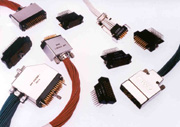 Photo ©1998 AMP INC.
Photo ©1998 AMP INC.Most metals of engineering interest readily oxidize when exposed to air. The oxide that forms on copper is largely cuprous oxide (Cu 2O) but sulfides and chlorides may also be formed depending on the environment. While some films impart resistance to further degradation, all of them pose a risk for circuit integrity. Oxides that form at the contact interface can cause an open circuit. The oxides are easily fractured due to contact forces, and wiping action can cause debris to accumulate, which can lift the contact from the opposing metal surface. Alloying elements such as Al, Fe, Ni, Sn, and Zn affect the corrosion mechanism and thus, the increase in contact resistance varies from alloy to alloy.
In order to minimize interface degradation, it is common practice to coat copper alloy contacts with tin, silver, gold, etc. Tin may also be applied by various techniques involving the use of molten metal. The electroplated coatings are not effective unless they prevent the elements in the base metal from diffusing through the plating and reaching the surface; thus there is a requisite plating thickness. In order to minimize plating thickness, a diffusion "barrier" of fifty microinches of nickel is often used. Because tin is prevalent throughout the industry for both general corrosion protection and as a contact surface, and because it is almost an inherent part of copper alloy strip, it is addressed in more detail in separate topics.
